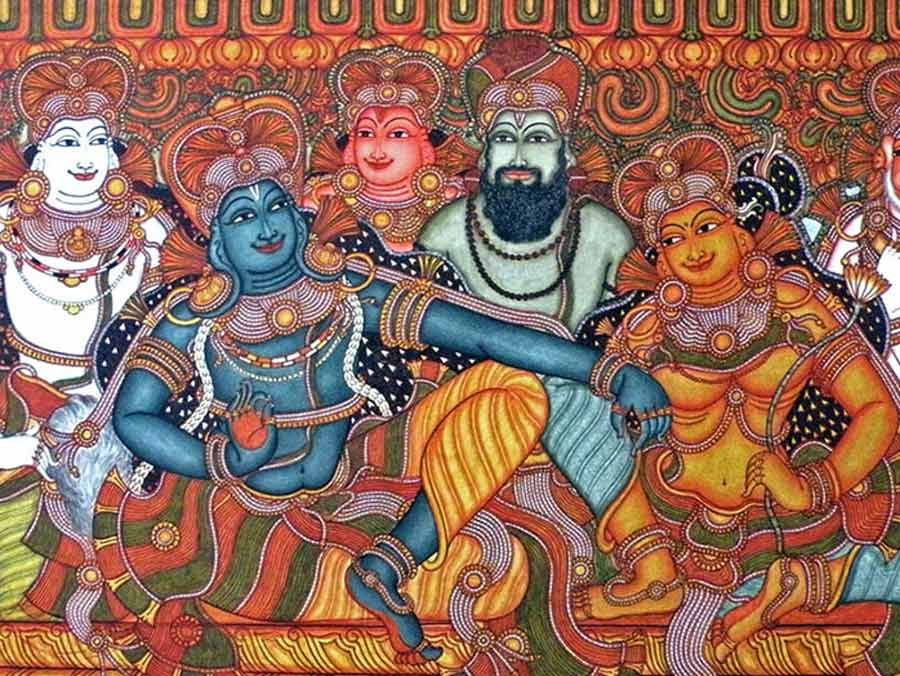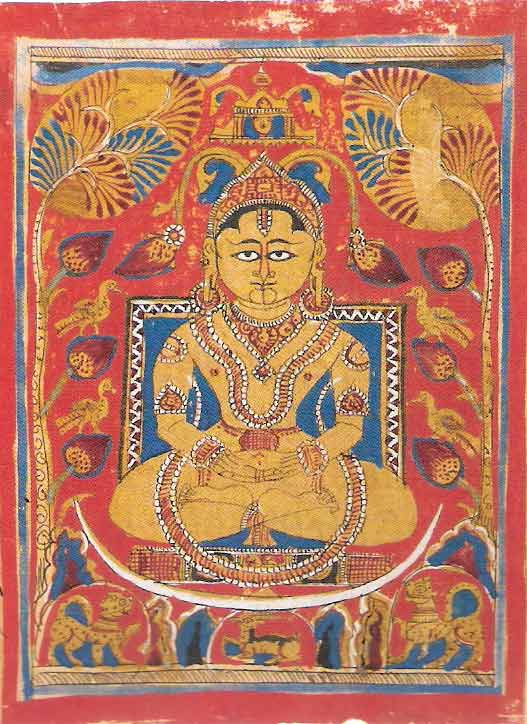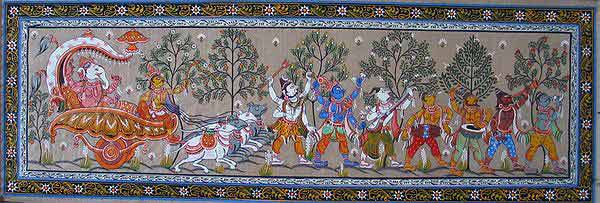
Temple Mural, Kerala, cc. 9th-12th century
Editor’s Note:
Alexis G. J. S. Sanderson is an Indologist and an Emeritus Fellow of All Souls College in the University of Oxford. After taking undergraduate degrees in
Classics and Sanskrit at Balliol College from 1968 to 1971, he spent six years in Kashmir studying with the Śaiva scholar and guru Swami Lakshman Joo. From
1977 to 1992 he was University Lecturer in Sanskrit and a Fellow of Wolfson College. In 1992 he was elected to the Spalding Chair of Eastern Religions and
Ethics and became a Fellow of All Souls.
Sanderson is a scholar of Sanskrit and of Indian religions, especially of Shaivism and esoteric Śaiva Tantra. In his own words, "The understanding of
Śaivism can only aspire to objectivity if it includes a sincere effort to see how things are in the subjective perception of its practitioners. One has to
be able to enter into the spirit of their world, to be with them intimately, to see what they are saying and why they are saying it, to go beneath the
surface of their texts. There has to be empathy."
This is the Introduction by Prof.Sanderson, which will be followed by further chapters.
Excerpt taken from In Honoris Causa: Essays in Honour of Aveek Sarkar, edited with a foreword by John Makinson (Allen Lane, 2015), pp. 155–224
INTRODUCTION
It is generally believed that already in the early mediaeval period from the fifth century of the Christian era onwards, if not earlier, there existed a
single Hindu religion, embracing Vaidika orthopraxy in accordance with primary and secondary Vedic revelation (Śruti and Smṛti) together with the sectarian
traditions of the worship of Viṣṇu, Śiva, Devī, and the Sun God (Sūrya), to mention only the foremost among the deities that attracted personal devotion,
that is to say, those whose worship is attested not only in countless temples surviving from that period in the Indian subcontinent and much of South East
Asia but also in numerous donative inscriptions and extensive bodies of prescriptive literature. It is also widely believed that this complex unity
displays an exemplary degree of religious tolerance, not only between Vaidikas, Vaiṣṇavas, Śaivas, Śāktas, and Sauras, but also between these and the
followers of the other two major Indian faiths of the age, namely Buddhism and Jainism.[1]

Vishvarupa, medieval miniature painting
One who wishes to challenge the first of these beliefs might begin by pointing out that before the advent of Islam India lacked any term even loosely
corresponding in its semantic range to that of the modern term Hinduism. Sanskrit sources differentiated Vaidika, Vaiṣṇava, Śaiva, Śākta, Saura, Buddhist,
and Jaina traditions, but they had no name that denotes the first five of these as a collective entity over and against Buddhism and Jainism.[2]
However, the absence of a name does not entail the absence of a corresponding concept. There is evidence, as we shall see, that by the end of the first
millennium of the Christian era the consensus had indeed come to conceptualize a complex entity corresponding to Hinduism as opposed to Buddhism and
Jainism, excluding only certain forms of antinomian Śākta-Śaiva observance that could not be reconciled with basic Vaidika values of ritual purity and the
separation of castes.
Conservative authorities continued to rail against this soft-focus ‘Hinduism’, with its blurring of the boundaries between the Vaidika and the non-Vaidika,
well into the second millennium of the Christian era, the Vaidikas insisting that the prescriptions of the Vaiṣṇava (Pāñcarātrika) and Śaiva scriptures are
invalid in their entirety, being based on scriptures that are not part of the Veda or rooted therein (vedamūla-),[3]the Śaivas insisting
on the absolute superiority of their own revelations and the ultimate inefficacity of those of the Vaidikas and the Vaiṣṇavas, and the Vaiṣṇavas insisting
that they too were Vaidikas in spite of Vaidika rejection and in keeping with this insistence fervently condemning the Śaivas,[4] in spite of the
fact that the Śaiva and Vaiṣṇava systems of observance have much more in common with each than either has with the Vaidika.[5] But the middle
ground saw in Śaivas and Pāñcarātrika Vaiṣṇavas proper, that is to say, in those who had taken initiation (dīkṣā) into these soteriologies and
practised their special rites, only variants of observance applicable to specific communities added to the ancient bedrock of Vaidika religion without
detriment to the latter; and this view came, as we shall also see, to be accepted not only by the orthoprax but also by many, perhaps even most, of the
initiated themselves. As for the uninitiated, whose only rite of religious empowerment had been the upanayanam that qualified a man for Vaidika
observance and the recitation of the Veda, they had themselves long since developed their own modes of Vaidika worship of the deities of the initiated and
integrated them into their daily rites, privileging one deity as an expression of personal devotion but generally including the others in a syncretistic
approach that, through its daily repetition in countless households, must have done much to express and nourish this sense of the greater unity that came
to be called Hinduism.

Mahavira's Nirvana from Kalpasutra, Patan, Gujarat. cc.1472
The thinking behind the concept of this as yet unnamed Hinduism is by its nature more tolerant than the views that we shall see below of the strict
adherents of its competing components. But it is strictly brahmanical: Buddhism and Jainism remain invalid in this thinking.
However, while certain states did at times adopt a hostile attitude towards these two non-Vaidika faiths, we may surmise that in general it was not politic
for Indian and Southeast Asian governments during the early mediaeval period to adopt a policy that strongly disadvantaged their Buddhist and, in the case
of the subcontinent, Jaina subjects. As we shall see, this supra-brahmanical perspective, which I see as an answer to the socio-legal question of what
forms of religion the state should tolerate or support and which are truly beyond the pale of the permissible, also finds its voice in the learned
literature of our period. Stopping short of accepting that all forms of religion are within the law or, rather, that any form of religion is above the law,
since it excludes the most blatant forms of antinomian observance, it nonetheless requires tolerance of these long-established traditions.
In this perspective it may be said that Indian and Southeast Asian states generally propagated tolerance in matters of religion. But it is not the case
that any of the individual religions that came within the purview of this tolerance were tolerant by nature. The long-entrenched contrary view, that the
Indian religions were essentially tolerant, cannot reasonably be maintained in the face of the carefully formulated views of the adherents of these Indian
traditions and evidence of sporadic outbreaks of intolerance and persecution. If the religions that flourished during the early mediaeval period in the
Indian subcontinent and Southeast Asia enjoyed in many regions and periods an enviable degree of peaceful co-existence, this must be explained not through
an argument from essence, which leads inevitably to the overlooking or dismissing of contrary evidence, but in terms of a balance of influence in which no
one religious tradition was in a position of such strength that it could rid society of its rivals, a balance of power sustained by the policy of
governments.

Hindu Gods, Chitra Painting
 If you value this knowledge please consider donating towards its production and dissemination worldwide in Sutra Journal. Be part of the effort to bring this knowledge to the world. Donations go towards the operating costs and promotion of the Journal.
If you value this knowledge please consider donating towards its production and dissemination worldwide in Sutra Journal. Be part of the effort to bring this knowledge to the world. Donations go towards the operating costs and promotion of the Journal.